- Faculty News
- Student News
- Lab News
- Publications
- Meetings and Presentations
- Outreach
- Grants
- Announcements
- About This Newsletter
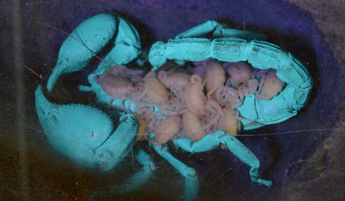
ABOVE: New additions to the family. Lyle Buss captured this great photo of our Asian forest scorpion with her brood by using the black light attached to her cage when he took the picture!
On June 5, 2014, a team of nine entomologists returned from a 12-day termite journey to Peru. The team drove from Lima, over the Andes (4, 818 m. elev.), to far western Amazonia, and back. The expedition yielded about 100 species including a number of new termite taxa and many new country records. This trip marks 25 years of termite diversity surveys beginning with a 1990 expedition to the Turks and Caicos Islands. To date, the UF collection contains over 40,000 colony samples in ethanol representing 1,788 collector-days of field work (not including contributions from African, Asian, and Australian colleagues, and the pest control community). There are about 140 undescribed species and over 1,000 described species in the collection. The collection is the largest contemporary (post-WWII) collection of termites in the world and has been the source for about 60 refereed journal articles.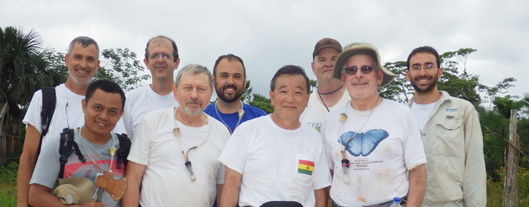
ABOVE: Peru Termite Survey Team. Back row (L to R): Rudolf Scheffrahn (UF FLREC), Reginaldo Constantino (Universidad de Brasília), Aaron Mullins (UF FLREC), John Mangold (Terminix International), and Tiago Carrijo (Universidad de São Paulo). Front row, (L to R): Eko Kuswanto (Institut Teknologi Bandung, Indonesia), Jan Keček (UF FLREC), Tom Nishimura (BASF Corp.), and Jim Chase (Terminix International).

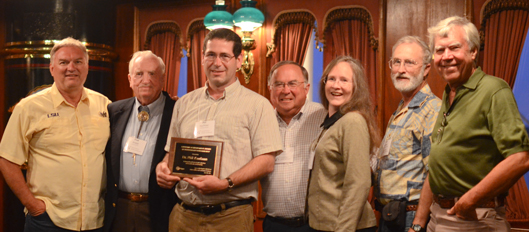
ABOVE: Dr. Phil Kaufman received the Lifetime Achievement Award in Veterinary Entomology in recognition of outstanding contributions to animal health and productivity. The award is sponsored by Bayer Animal Health and the 58th Annual Livestock Insect Workers’ Conference and was presented on June 24 in San Diego, CA. Dr. Kaufman is pictured here with several past recipients of the Lifetime Achievement Award.
 Dr. Marc Branham was interviewed by Ira Flatow on National Public Radio’s Science Friday radio show this 4th of July. Dr. Branham talked about firefly biology and evolution, and suggested activities for how adults and children can communicate with fireflies in their own backyards.
Dr. Marc Branham was interviewed by Ira Flatow on National Public Radio’s Science Friday radio show this 4th of July. Dr. Branham talked about firefly biology and evolution, and suggested activities for how adults and children can communicate with fireflies in their own backyards.
A brief video about fireflies, composed of excerpts from the upcoming documentary Brilliant Darkness, is featured on the NPR Science Friday website. This video included interviews from Dr. James Lloyd and Dr. Marc Branham.
Last month, Dr. Marc Branham was interviewed and some of his firefly research filmed for a National Geographic/NOVA special on bioluminescence. Filming on this project will continue into 2015 with an anticipated release date of 2016. Dr. Branham’s firefly research is featured on the UF Office of Research homepage.
 Dr. Billy Crow and his graduate student Tina Gu, along with colleague Dr. Bruce Martin and his graduate student Brad Shaver from Clemson University, were invited to spend a week in Switzerland as guests of Syngenta Lawn and Garden. They each made presentations of their research with Syngenta chemistries and learned a great deal about the pesticide business.
Dr. Billy Crow and his graduate student Tina Gu, along with colleague Dr. Bruce Martin and his graduate student Brad Shaver from Clemson University, were invited to spend a week in Switzerland as guests of Syngenta Lawn and Garden. They each made presentations of their research with Syngenta chemistries and learned a great deal about the pesticide business.
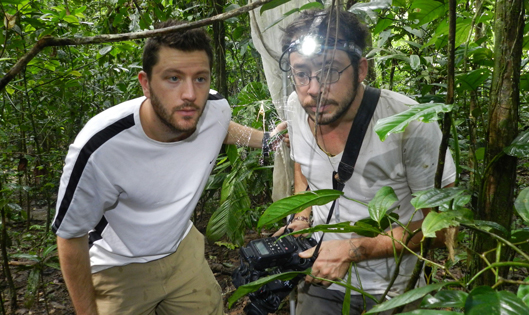
ABOVE: Lary Reeves (right) and Aaron Pomerantz (left)traveled to Peru to work on Cyclosa dummy spiders, research being covered by BBC. Here is the link to an article in Popular Science that covers this amazing story.
 Sandy Koi, a recent M.S. graduate under the direction of Dr. Jaret Daniels, has accepted a permanent position as the staff biological scientist with Dr. Catharine Mannion at the UF Tropical Research and Education Center campus in Homestead. She will be pursuing her Ph.D. studying the pests that attack ornamental plants, including the cycad host plants for the state-imperiled Atala butterfly, Eumaeus atala (the subject of her Master's degree).
Sandy Koi, a recent M.S. graduate under the direction of Dr. Jaret Daniels, has accepted a permanent position as the staff biological scientist with Dr. Catharine Mannion at the UF Tropical Research and Education Center campus in Homestead. She will be pursuing her Ph.D. studying the pests that attack ornamental plants, including the cycad host plants for the state-imperiled Atala butterfly, Eumaeus atala (the subject of her Master's degree).

Listed below are the students in our program who made the CALS Dean’s List for Spring 2014. Overall, more than 750 CALS students made the spring Dean’s List.
Deanna Bott, Heather Erskine, Abigail Griffin, Stefani Harrison, Sabrina Leisinger, Casey Parker, Samuel Pass, Anthony Riggio, and Sigal Szejner.
 Tina Gu successfully defended her M.S. thesis “The efficacy of potential nematicides for golf courses in Florida.”
Tina Gu successfully defended her M.S. thesis “The efficacy of potential nematicides for golf courses in Florida.”

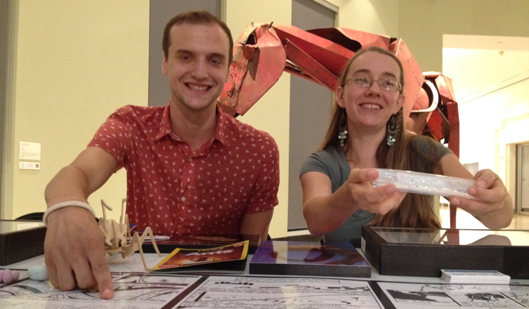
ABOVE: Sedonia Steininger and Tyler Vitone presented the Lucky Lab's citizen science projects at the Harn Museum of Art's 'Museum Night' on June 12. The theme was Natural Wonders, and Sedonia and Tyler demonstrated School of Ants and Backyard Bark Beetles for the attendees.

Ms. Nathalia Gomez joined the laboratory of Dr. James P. Cuda on 8 June. Ms. Gomez, a gifted high school student who hails from St. Lucie Co., is participating in the 56th Annual Student Science Summer Training Program, which is sponsored by the UF Center for Precollegiate Education and Training. Nathalia will be assisting with host range studies on the Brazilian peppertree stem boring weevil, Apocnemidophorus pipitzi.
Ms. Shannon Moore, an undergraduate student majoring in Wildlife Ecology and Conservation at UF, joined the laboratory of Dr. James P. Cuda on 30 June. Ms. Moore was awarded an FAES Summer Internship to study the impact of the stem boring weevil A. piptizi on Brazilian peppertree.
Need to name that bug? A host of experts are available to help Floridians identify any insect or related arthropod. If a mystery creature has six or more legs, the UF Insect ID Lab is the place to call.
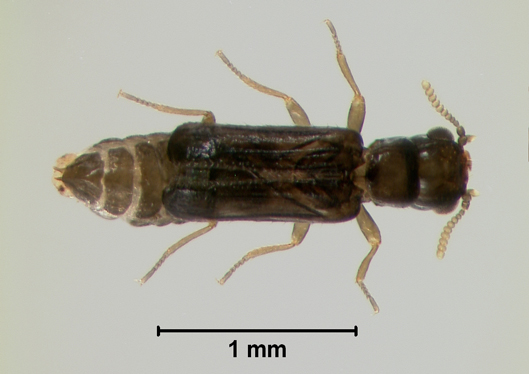
ABOVE: Occasionally, the UF Insect ID Lab recieves samples of this minute beetle from inside a house. The samples may include only larvae, only adults, or both. At first glance, the adult resembles a rove beetle, but it actually is the sole member of the family Micromalthidae. It is Micromalthus debilis, also called the telephone-pole beetle. The larvae are wood borers and can be found in moist, decaying oak logs. Indoors, they can develop in wood that stays moist because of a water leak or condensation. They are a nuisance pest indoors because dozens or hundreds of them may be found, but the bigger issue for homeowners is finding and correcting the problem that is causing the moist wood.
Lyle Buss is the Insect ID Lab manager.
 Think it might be a nematode problem? The Nematode Assay Laboratory serves Florida and other states by providing nematode assays and expert advice regarding nematode management.
Think it might be a nematode problem? The Nematode Assay Laboratory serves Florida and other states by providing nematode assays and expert advice regarding nematode management.
For more information on the Nematode Assay Laboratory please contact the lab manager Dr. Tesfa Mengistu.
Alto BW, Richards SL, Anderson SL, Lord CC. 2014. Survival in West Nile virus challenged southern house mosquito Culex pipiens quinquefasciatus in relation to environmental temperature. Journal of Vector Ecology 39: 123-133.
Dickey AM, Trease AJ, Jara-Cavieres A, Kumar V, Christenson MK, Portluri LP, Morgan JK, Shatters RG, McKenzie CL, Davis PH, Osborne LS. 2014. Estimating bacterial diversity in Scirtothrips dorsalis Hood (Thysanoptera: Thripidae) via next generation sequencing. Florida Entomologist 97: 362-366.
Kumar V, Seal DR, Osborne LS, McKenzie CL. 2014. Coupling SEM with DNA barcoding: A novel approach for thrips identification. Applied Entomology and Zoology DOI: 10.1007/s13355-014-0262-2.
Kumar V, Wekesa V, Avery PB, Powell CA, McKenzie CL, Osborne LS. 2014. Effect of pollens of various ornamental pepper cultivars on the development and reproduction of Amblyseius swirskii (Acari: Phytoseiidae). Florida Entomologist 97: 367-373.
Lucky A, Savage AM, Nichols LM, Castracani C, Shell L, Grasso DA, Mori A, Dunn RR. 2014. Ecologists, educators, and writers collaborate with the public to assess backyard diversity in The School of Ants Project. Ecosphere 5: 78.
Martini X, Hoyte A, Stelinski LL. 2014. Abdominal color of the Asian citrus psyllid (Hemiptera: Liviidae) is associated with flight capabilities. Annals of the Entomological Society of America 107: 842-847.
McKenzie CL, Kumar V, Palmer CL, Oetting RD, Osborne LS. 2014. Chemical class rotations for control of Bemisia tabaci (Hemiptera: Aleyrodidae) on poinsettia and their effect on cryptic species population composition. Pest Management Science DOI: 10.1002/ps.3736.
Seal DR, Kumar V, Kakkar G. 2014. Management strategy for control of Frankliniella schultzei (Thysanoptera: Thripidae) in tomato: a principal vector of Groundnut Ring Spot Virus. Florida Entomologist 97: 374-383.
Wang D, Bowman DD, Brown HE, Harrington LC, Kaufman PE, McKay T, Nelson CT, Sharp J, Lund R. 2014. Key factors influencing canine heartworm (Dirofilaria immitis) prevalence. Parasites and Vectors 7: 264. DOI: 10.1186/1756-3305-7-264
 New on Featured Creatures:
New on Featured Creatures:
Bagrada bug, Bagrada hilaris (Burmeister) Authors: Eric LeVeen and Amanda C. Hodges, Entomology and Nematology Department, University of Florida
hydrellia fly parasitic wasp, Trichopria columbiana Ashmead Authors: Byron R. Coon, Argosy University, Nathan E. Harms, US Army Engineer Research & Development Center, Michael J. Grodowitz, US Army Engineer Research & Development Center, Emma N. I. Weeks, University of Florida, James P. Cuda, University of Florida
hydrilla tuber weevil, Bagous affinis Hustache Author Emma Weeks, Entomology and Nematology Department, University of Florida
Do you have a favorite creature? Learn how to make it into a Featured Creature!
News from the 6th International Congress of Nematology
Every six years, the nematologists around the globe suspend all their regular meetings and meet together for an International Congress of Nematology (ICN). This year, the ICN was held in Cape Town, South Africa. Our faculty and students were well represented at this event. From Gainesville, Don Dickson, Billy Crow, Tesfa Mengistu, and graduate students Tina Gu, Richard Baidoo, Kanan Kutsuwa, and Silvia Vau made the trip, along with REC faculty and staff Robin Giblin-Davis, Joe Noling, Larry Duncan, and Fahiem El-Borai.
Presentations:
Baidoo R, Stamps RH, and Crow WT. Pathogenicity and management of Meloidogyne incognita on Pittosporum tobira in Florida.
Brito JA, Vau SJ, and Dickson DW. Host status of selected sweet potato cultivars to Meloidogyne enterolobii.
Crow WT, and Dant L. Treatment zone of abamectin in golf course greens.
Duncan L. Global metrics to measure the impacts of nematodes: Then what?
El-Borai F, Killiny N, and Duncan L. Does soil water potential cause allelopathy among closely related steinernematid species in Florida?
Giblin-Davis RM, Kanzaki N, and Davies KA. Diversity of entomophilic nematodes and the threat of cryptogenic invasive species.
Gu M, and Crow WT. Efficacy of two abamectin formulations on Belonolaimuis longicaudatus in greenhouse and field trials.
Kanzaki N, Giblin-Davis RM, Carrillo D, Duncan L, and Gonzalez R. Bursaphelenchus sp. (Tylenchomorpha: Aphelenchoididae) a phoretic associate of Xyleborinus gracilis (Coleopytera: Scolytinae) from avocado in Florida.
Kanzaki N, Giblin-Davis RM, and Davies KA. Diversification of termite-associated nematodes in relation to evolutionary patterns of diversity.
Kanzaki N, Giblin-Davis RM, and Davies KA. Diversity of fig-associated nematodes as a model system for studying biogeography, host switching and colonization of new habitats.
Kanzaki N, Giblin-Davis RM, Herre EA, and Center BJ. Parasitodiplogaster species associated with Pharmacosycea figs in Panama.
Kanzaki N, Tanaka NR, Giblin-Davis RM, and Davies KA. A Bursaphelenchus species has become a plant-parasite in figs and converged in appearance with Schistonchus.
Kutsuwa K, Dickson DW, Brito JA, Jeyaprakash A, and Drew A. Investigations of an emerging pathogen, Belonolaimus sp., infecting peanut in Florida, USA.
Mekete T, Joseph S, Hewlett T, Watrin C, and Schmidt L. Creation of Pasteuria penetrans clonal lines for study of variation in Pasteuria spp. populations relating to host virulence.
Noling JW. Current nematicide options and their integration with IPM strategies.
Seid A, Wesemael WML, Decreamer W, Mekete, TM, and Fininsa C. Biodiversity of root-knot nematodes (Meloidogyne spp.) from major tomato growing areas of Ethiopia.
Vau S, and Dickson DW. Effectiveness of resistant tomato cultivars for management of root-knot nematodes in Florida.
UF sweeps second place!
UF graduate students Silvia Vau and Tina Gu won second place in the best student poster competition and the best student paper competition, respectively. Great job ladies!
Hail to the chief!
Larry Duncan was installed as President of the Organization of Nematologists of Tropical America (ONTA). He also was installed as President of the International Nematology Federation (INF).
 The Bark & Ambrosia Beetle Academy
The Bark & Ambrosia Beetle Academy
Just a few weeks ago, the Entomology & Nematology building saw a large group of people scurrying around the hallways like a little bark beetle colony in their subcortical gallery. The Department hosted the Bark & Ambrosia Beetle Academy. From May 8 to May 13, thirty participants from around the world (Australia, Germany, South Africa, Puerto Rico, Norway, Guam, Italy, and many US states from Connecticut to California) convened here to learn, discuss, and have fun collecting bark and ambrosia beetles. We also hosted several IFAS Extension county faculty.
The Academy was split into three modules, covering everything from beetle management, to hands-on training in identification, to techniques for field collection (including an exciting night light-trapping event at the new fancy SFRC Learning Center in the Austin Cary Forest), and specialized topics ranging from molecular identification to bark beetle acoustics.
The team was extraordinary – our ENY M.S. student Sedonia Steininger essentially ran the show, and several other people from the Hulcr lab were always at hand (Caroline Storer, Craig Bateman, Andrew Johnson and Adam Black). The main attraction was probably the array of heavyweights from the scolytine beetle research community, including the world’s most prominent systematists, ecologists and management researchers.
We would like to thank the Entomology and Nematology Department for the facilities that were made available, and to the many individuals who supported us during the event, particularly Nick Hostettler, Elena Alyanaya, and Dr. Andrea Lucky whose lab turned into a temporary bark beetle junk storage. We are also grateful to Kate Okins from the Department of Plant Inspection for providing specimens and identification expertise and Jeff Eickwort from the Florida Forest Service for helping us to locate field sites. The School of Forest Resources and Conservation graciously provided vans for transport and the beautiful Learning Center. This was a prime example of a symbiosis between the two Departments.
 Dr. Marc Branham gave an invited presentation in the Institute of Learning in Retirement seminar series titled Bioluminescence and Courtship Communication in Fireflies.
Dr. Marc Branham gave an invited presentation in the Institute of Learning in Retirement seminar series titled Bioluminescence and Courtship Communication in Fireflies.
 Ms. Nathalia Gomez presented an overview of her summer research project on the Brazilian peppertree weevil A. pipitzi as part of the SSTP midterm oral presentation program held on campus at the Health Professions, Nursing and Pharmacy Complex, 27 June.
Ms. Nathalia Gomez presented an overview of her summer research project on the Brazilian peppertree weevil A. pipitzi as part of the SSTP midterm oral presentation program held on campus at the Health Professions, Nursing and Pharmacy Complex, 27 June.

Dr. Christine W. Miller and six current and former members of the Miller Lab attended the Evolution 2014 conference in Raleigh, NC. Presentations included the following:
Dr. Christine W. Miller presented a talk titled "The condition dependence of sexual dimorphism in Narnia femorata”
Daniel Sasson (Ph.D. candidate) presented a talk titled "The role of genes and the environment on a pre and post copulatory reproductive traits"
Savannah Nease (former undergraduate researcher) presented a poster titled "Male mate choice and female receptivity lead to reproductive interference"
Dr. Jennifer Hamel (Postdoctoral associate) presented a talk titled " Are female mating decisions adaptive when environments vary? A test using natural resource variation"
Pablo Allen (Ph.D. candidate) presented a talk titled "Sexual dimorphism is disrupted in a novel environment"
 Dr. Billy Crow was a speaker at the Northwest Florida Turf Field Day in Jay on 18 June.
Dr. Billy Crow was a speaker at the Northwest Florida Turf Field Day in Jay on 18 June.
Dr.
Billy Crow conducted a half-day turfgrass nematode workshop for employees of Quali-Pro at the PSREU in Citra on June 17.
Dr. Billy Crow conducted a lawn nematode training for landscape staff at The Villages on 20 June.
From the Outreach Coordinator
The live critters are always a hit with children and adults alike. The critters are available for you to check out should you be leading an outreach event. We have doubles of our most popular critters, as well as various native insect species depending on the time of year. We have large wood and Plexiglas cages for viewing our native orb weaving spiders. There is one travel cage and one larger static cage. Please be sure to contact us and review the protocol on transporting and handling the critters if you are not already familiar with it. If you lead an outreach, be sure to fill out a documentation form so your event can be included in the newsletter and we can log all outreach events.
If you would like to schedule an event or have any outreach questions, go to the Outreach pages on our Bug Club Website and contact us.
- Stephanie Stocks, Outreach Coordinator
- Office number 352-273-3958
 Getting social!
Getting social!
We have several social media sites for the Entomology & Nematology Department. To make them easily searchable, all three (YouTube, Facebook and Twitter) have the same page name: UFEntomology. Please share these links with past students or colleagues who may have an interest in departmental activities.
Virni Mattson, our grants specialist, reports that we have so many grants to process this month that we will report our May and June external funding for all Entomology & Nematology faculty (in Gainesville and at RECs) next month!
Dr. William A. Overholt and Dr. James P. Cuda were awarded a $34,265 research grant by the FWC, Bureau of Invasive Plant Management to conduct foreign exploration for natural enemies of the invasive cogongrass, Imperata cylindrica, in Africa, Japan and Indonesia.
Dr. James P. Cuda was awarded a $1,000 travel grant to participate in the S1058 Multistate Regional Project “Biological Control of Arthropod Pests and Weeds,” which is held in conjunction with the annual ESA-SEB meeting.
August 3rd to the 6th, 2014, at the Jupiter Beach Resort and Spa in Jupiter, Florida.
Pre-registration deadline for the meeting has passed. Payment may be made at the meeting. Registration forms can be found on the website under the Annual Meeting tab.
We like to share news when it happens using our social media outlets: Twitter, Facebook and YouTube. Follow us on these sites for daily updates! When you send news, we will post it on one or more of these sites and again in the monthly newsletter. Please be sure you have permission from people in photographs you submit for publication.
UF-Bugnews-L listserv subscribers receive notices when issues are posted. Our home page has instructions for subscribing and unsubscribing.
Special thanks to Dr. Verena Lietze and Nancy Sanders, who reviewed the newsletter for errors, and to Jane Medley and Don Wasik, who built the web page design.